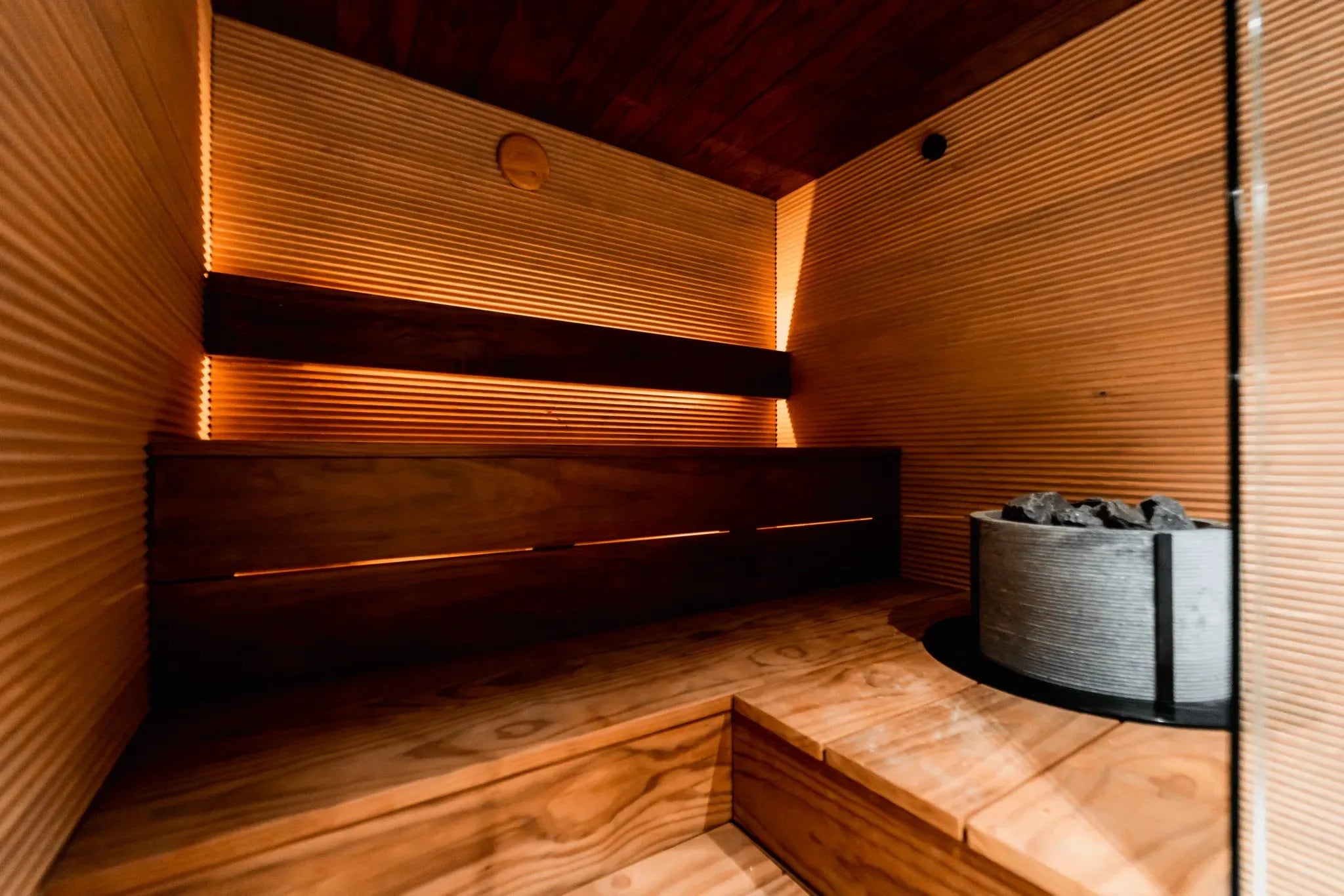Sauna bathing is deeply rooted in the hearts of us Finns, and the atmosphere and appearance of the sauna are important parts of creating the sauna experience. Sauna panels greatly affect the sauna's atmosphere, as a large part of the sauna surfaces are paneling. Pick up tips for choosing, treating, and installing sauna panels from this blog post!
SAUNA PANELS FROM MANY DIFFERENT MATERIALS
A sauna needs the right products and materials due to high heat and moisture fluctuations. With the right materials and treatment, you get a long-lasting and high-quality sauna that brings joy for a long time.
Finnish pine is the most common forest tree in Finland and an important commercial wood. Pine panels are a very familiar sight in Finnish saunas, as pine is readily available and, when properly treated, is an excellent material for saunas. Some may fear pine panels exuding resin in the sauna, but in modern saunas, the temperature rarely rises above 100 degrees Celsius, which is when actual resin exudation begins.
Panels made from pine are available in many different profiles both ready-to-use and pre-treated for sauna protection or thermally treated. Ready-to-use panels must always be treated with the appropriate treatment agent, and we will discuss panel treatment further later in this article. Next, let's explore thermally treated panels!

The traditional ready-to-use pine panel is also excellently suited for sauna when properly treated.
Thermally treated sauna panels are warm dark brown in color and are suitable for both indoor and outdoor use. Thermal treatment is based on enhancing the durability properties of the wood. Thermal treatment improves the wood's natural properties using heat and steam without chemicals. Thermally treated panels are made from, among others, pine, spruce, radiata pine, and aspen.
Thermally treated radiata pine is a premium-class sauna material. The product's shade is darker than ordinary thermally treated pine, and the beautiful grain pattern of the wood is clearly visible. The thermal panel is recommended to be treated with paraffin oil, which further deepens the beautiful brown shade. Radiata pine originates from the west coasts of North America and is grown in New Zealand, Australia, Chile, and South Africa.

Thermally treated radiata pine panel is known for its very high quality. The panel is completely resin-free and non-toxic, so the wood surface hardly heats up even at high temperatures.
Finnish spruce is a high-quality and versatile material. Spruce withstands heat and moisture fluctuations well, making it a good and popular product for saunas. The light, straight-grained spruce panel is a very traditional choice for sauna material. Especially for cottages that are left unheated, the most durable wood material is spruce, as the resin in spruce protects the wood from moisture. Untreated spruce is recommended to be treated with sauna protective agent.

Spruce is a high-quality material for sauna use, as it withstands heat and moisture fluctuations well.
Alder is a familiar sight as sauna bench material and is also a popular material for sauna panels. Its lack of resin, even color, and pleasant scent make alder an excellent material for saunas. Alder has a beautiful light brown shade with a moderate grain pattern. Thanks to its light structure, the material does not overheat, and the light color brings brightness to sauna spaces.
Aspen is a light wood whose surface and heartwood are not clearly distinguishable. Untreated aspen is often chosen as sauna material because of its light appearance and good technical properties. Aspen is almost white in color and has an even tone. Currently, alder and aspen panels are poorly available due to the challenging availability of raw materials caused by the global situation.
DURABILITY AND ATMOSPHERE THROUGH TREATMENT
Proper treatment of sauna panels is an important part of the sauna's durability and maintaining a beautiful appearance. Carefully selected treatment agents and proper application provide wood surfaces protection against moisture and dirt, while also creating the desired atmosphere. Thanks to the treatment, sauna cleaning is also easier.

Sauna treatment significantly affects the sauna's atmosphere.
The first treatment should be done before installing the panels. This way, you avoid unpainted gaps after the wood has dried. There are several options for treating sauna panels, and the choice of treatment agent depends on the desired final result. Here are some popular options for sauna treatment:
- Sauna protective agent: Sauna protective agents are specifically intended for wooden surfaces used in saunas. They protect panels from moisture, dirt, and other damage by forming a thin water- and dirt-repellent protective layer on the panel's surface. It is not advisable to apply sauna protection too thickly, as a thick layer makes the surface glossy and may make the panel's surface unpleasantly hot against the skin.
- Natural oils: Another popular option is to use natural oils for treating the panels. The oil penetrates the wood and deepens the wood's own shade and grain. A good option is, for example, non-toxic and environmentally friendly paraffin oil, which is suitable for walls, ceilings, and benches alike.
- Wax: Wood wax is also an option for treating sauna panels. The wax layer protects the wood from moisture while creating a beautiful, natural surface. Choose a wood wax suitable for sauna use and apply it evenly to the wood surface following the manufacturer's instructions.
If you want to keep it easy and start enjoying the sauna as soon as possible, choose a pre-treated product. From our sauna panel selection, you will find pre-tinted and sauna-protected panels that are ready to use as is and are immediately ready for installation.

Made of spruce sauna panel is surface-treated with a charcoal-colored sauna protector, giving the wood a natural, beautiful smoke sauna-like shade
INSTALLATION DIRECTION AND FEATURE PANELS FOR A SAUNA THAT LOOKS JUST LIKE YOU
The direction in which you install the panels can significantly affect the sauna's visual appearance. Most commonly, sauna panels are installed horizontally, which creates a calm and balanced impression. Horizontally installed panels emphasize the sauna's width and make the space feel larger. If, on the other hand, you want to emphasize the sauna's height, install the panels vertically. Note that when paneling vertically, cross battens must be installed. This is a bit more laborious, as in addition to the vertical battens, horizontal battens must also be installed, but the end result may be worth all the effort!

Horizontal paneling is a common sight in saunas. Thermally treated Dune Panel adds character to this sauna.
By combining different installation directions, you create contrast and interest on the sauna surfaces. For example, install one wall vertically and the other wall panels horizontally. This way, you can highlight certain features of the space and create visual dynamics. Additionally, you can try different materials and colors to add even more variety and personality to the sauna surfaces.
Various accent panels also offer the opportunity to create contrast in the sauna interior. You can consider paneling all the sauna walls with an accent panel and choose a more subdued and traditional option for the ceiling. Alternatively, you can highlight the sauna ceiling with your chosen accent panel – only your imagination is the limit!
Also remember to consider the sauna lighting when planning different installation directions. Lighting can highlight and create fun shadows. Lighting significantly affects the sauna atmosphere and combined with paneling creates a polished and stylish whole.

Feel free to try different installation methods and let your creativity soar! Sauna surfaces can become surprisingly versatile and attractive when you play with different directions, materials, and colors. However, remember to keep the overall look balanced and harmonious so that the result is polished and pleasing to the eye even after a long time.

The combination of black-treated log and a "continuous" finger-jointed panel from ceiling to wall finger panel creates a stunning and stylish contrast.
INSTALLATION OF SAUNA PANELS
Sauna paneling is surprisingly easy and can be done well even by a home carpenter. The paneling itself is done much the same way as paneling a regular interior wall, but the preparatory work in a sauna is naturally a bit more laborious, as proper insulation and a vapor barrier must be installed. In this article, we briefly focus on sauna paneling and the most important points to consider when paneling a sauna. If you need comprehensive instructions for paneling, check out our paneling guides. More tips and instructions specifically on sauna construction and sauna material options can be found, for example, on the Saunalogia website.

Sauna paneling is done very similarly to paneling a regular interior wall.
Let's briefly go through the steps of sauna paneling. After insulation and vapor barrier, sauna paneling proceeds as follows:
- Make battens on the ceiling and walls.
- Panel the ceiling first.
- Reinforce the walls as needed for attaching the stove and benches.
- Start paneling the walls from the "rearmost" wall.
- Use galvanized nails for installing the panels to prevent rusting.
Finish the paneling as needed with moldings suitable for the sauna.

Made from thermally treated radiata pine Thermo dune panel is a premium-class sauna panel.
Order a free sample piece for a closer look and planning.



